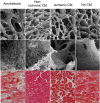Common mechanistic pathways in cancer and heart failure. A scientific roadmap on behalf of the Translational Research Committee of the Heart Failure Association (HFA) of the European Society of Cardiology (ESC)
- PMID: 33094495
- PMCID: PMC7894564
- DOI: 10.1002/ejhf.2029
Common mechanistic pathways in cancer and heart failure. A scientific roadmap on behalf of the Translational Research Committee of the Heart Failure Association (HFA) of the European Society of Cardiology (ESC)
Abstract
The co-occurrence of cancer and heart failure (HF) represents a significant clinical drawback as each disease interferes with the treatment of the other. In addition to shared risk factors, a growing body of experimental and clinical evidence reveals numerous commonalities in the biology underlying both pathologies. Inflammation emerges as a common hallmark for both diseases as it contributes to the initiation and progression of both HF and cancer. Under stress, malignant and cardiac cells change their metabolic preferences to survive, which makes these metabolic derangements a great basis to develop intersection strategies and therapies to combat both diseases. Furthermore, genetic predisposition and clonal haematopoiesis are common drivers for both conditions and they hold great clinical relevance in the context of personalized medicine. Additionally, altered angiogenesis is a common hallmark for failing hearts and tumours and represents a promising substrate to target in both diseases. Cardiac cells and malignant cells interact with their surrounding environment called stroma. This interaction mediates the progression of the two pathologies and understanding the structure and function of each stromal component may pave the way for innovative therapeutic strategies and improved outcomes in patients. The interdisciplinary collaboration between cardiologists and oncologists is essential to establish unified guidelines. To this aim, pre-clinical models that mimic the human situation, where both pathologies coexist, are needed to understand all the aspects of the bidirectional relationship between cancer and HF. Finally, adequately powered clinical studies, including patients from all ages, and men and women, with proper adjudication of both cancer and cardiovascular endpoints, are essential to accurately study these two pathologies at the same time.
Keywords: Angiogenesis; Cancer; Cardio-oncology; Cardiotoxicity; Clonal haematopoiesis; Extracellular matrix; Heart failure; Inflammation; Metabolism.
© 2020 The Authors. European Journal of Heart Failure published by John Wiley & Sons Ltd on behalf of European Society of Cardiology.
Figures




References
-
- Shen L, Jhund PS, Petrie MC, Claggett BL, Barlera S, Cleland JGF, Dargie HJ, Granger CB, Kjekshus J, Køber L, Latini R, Maggioni AP, Packer M, Pitt B, Solomon SD, Swedberg K, Tavazzi L, Wikstrand J, Zannad F, Zile MR, McMurray JJ. Declining risk of sudden death in heart failure. N Engl J Med 2017;377:41–51. - PubMed
-
- Moliner P, Lupon J, de Antonio M, Domingo M, Santiago‐Vacas E, Zamora E, Cediel G, Santesmases J, Díez‐Quevedo C, Troya MI, Boldó M, Altmir S, Alonso N, González B, Núñez J, Bayes‐Genis A. Trends in modes of death in heart failure over the last two decades: less sudden death but cancer deaths on the rise. Eur J Heart Fail 2019;21:1259–1266. - PubMed
-
- Meijers WC, Maglione M, Bakker SJ, Oberhuber R, Kieneker LM, de Jong S, Haubner BJ, Nagengast WB, Lyon AR, van der Vegt B, van Veldhuisen DJ, Westenbrink BD, van der Meer P, Silljé HH, de Boer RA. Heart failure stimulates tumor growth by circulating factors. Circulation 2018;138:678–691. - PubMed
Publication types
MeSH terms
Grants and funding
LinkOut - more resources
Full Text Sources
Medical
Research Materials
Miscellaneous

